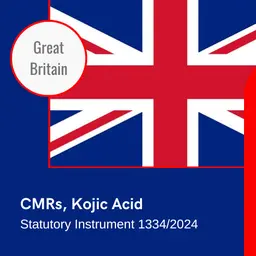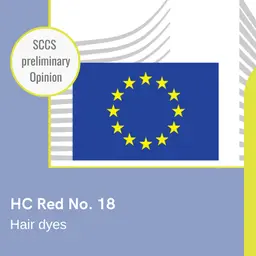
Light control in cosmetics began with the effects of pigments and fillers used to modify colour perception or skin appearance. We will not return in this contribution on the white powders allowing the make-up, like the famous powder of ceruse (in fact lead carbonate which caused many worries) nor on the telluric loads like talc, kaolin, mica and others treated elsewhere, or on the famous powder of rice of our grandmothers. Theatre has often been a driving force with iconic brands such as Dorin or Bourjois. But as has often been the case, it is with cinema that modern cosmetics has seen its most interesting advances.
Most early American silent films were made in black and white, using blue-sensitive or orthochromatic film as the filmstrip. These films were insensitive to red light, which meant that in black and white works, reds were black and natural skin looked dark on the screen. Applying cinema make-up was problematic and many early actors resorted to blue, green and / or bright yellow make-up to achieve an appropriate result, or all white to lighten the skin. Things must have looked very strange on the early films!
The contribution of the cinema and the pancake
The panchromatic film partially resolved this question. As the name suggests, this film is sensitive to the entire visible spectrum, and as a result, black and white films had more faithful colors than blue or orthochromatic tones. Experiments with panchromatic films took place as early as 1913 in the United States. They were used in some American films as early as 1918.
Although panchromatic film has a wider spectrum sensitivity than blue sensitive or orthochromatic film, its use has been limited by being less stable, slower, and more expensive. In 1923, Eastman Kodak began commercial production of a new, more stable, faster, and panchromatic media.
The move in Hollywood from orthochromatic sensitive films to panchromatic films has been very rapid. In addition to lowering its price, Eastman Kodak actively began promoting a new film, highlighting its ability to more faithfully render close-up skin tones and produce better images of landscapes and skies in open-air scenes. air.
The release by Du Pont of his panchromatic film in the US market in 1928 and the introduction by Eastman Kodak of Ciné Panchromatic Type II film in the same year, also accelerated this process. By the time Eastman Kodak premiered his film Ciné Panchromatique Super-Sensitive in 1931, the conversion was largely complete.
Although panchromatic film could record light across the entire visible spectrum, it was more sensitive to blue than to red, unlike incandescent lamps which emitted more in the blue. So makeup was needed that balanced the colors and produced a monochrome image that looked natural to the human eye.
Max Factor was very involved in this work. She sent make-up artist Edward Kaufman to participate in the “Mazda tests”, named after the lamps of the time. During the four months of testing, the company succeeded in developing a panchromatic makeup that took into account the differences between the color sensitivity of the panchromatic film and the human eye, as well as the spectral characteristic of incandescent lamps. Max Factor, very involved in this research, thus tried to keep the new panchromatic makeup as natural as possible.
He has developed a whole series of specific “product” answers to these referencing questions. They were often made from what is called “greasepaint”, a kind of make-up product made of fat and powder. These products were developed in the mid-19th century in the theater world, in particular by Leichner, a big name in theatrical makeup, already as a response to light sources that had become more powerful.
Despite its excellent qualities, such as its ability to hide skin blemishes in close-ups, “greasepaint” exhibited major failings when it came to color film. Furthermore, the response was essentially colorimetric.
In fact, it is to Technicolor and the problems it posed that we owe the birth of a great family of cosmetics, pancakes. Technicolor is a series of color film processes pioneered by the Technicolor Motion Picture Corporation, founded by Herbert Kalmus, Daniel F. Comstock and WB Westcott in 1914.
Originally used in 1916, Technicolor's evolution has been patchy, and it wasn't until the Technicolor Process 3 was developed in the late 1920s that it began to gain traction in Hollywood studios.
Although a number of films were made using this new process during the Great Depression (1929 and beyond), Hollywood studios reduced their production until 1932, when a new tri-chromic camera (called a chromic camera). three-band or Technicolor Process 4) has been developed.
The Technicolor trichrome camera is loaded with three black and white negatives which are driven in perfect synchronism by the same mechanism, one being sensitive to red, the other to green and the last to blue. This camera simultaneously exposed all three bands to record red, green and blue light on three separate negatives. These were then combined to produce a full color projection impression.
With the introduction of this technique, many problems had to be solved. One of them was makeup. When Technicolor began to be widely used in studios, brighter lighting was needed to get enough light, as well as green and blue negatives. Suddenly, in brighter lights, the light layer of fat left on the skin shone, revealing the colors and reliefs due to the environment, or similar colors on the stage.
The make-up specialists of the time then sought solutions from specialists. In 1935, Elisabeth Arden bought the DeLong and Make-up Studio laboratories in Hollywood and used them to create the Screen and Stage division of Elizabeth Arden. Nuchromatic makeup, acquired by Arden when purchasing DeLong, has been used in several Technicolor films.
For his part, Max Factor, this big name in professional makeup, was also looking for a better solution to the makeup problems posed by Technicolor. In the late 1930s, the Max Factor company took a different approach to the problem. After more than two years of experimentation, both at the Factor lab and at Technicolor, a new makeup, known as the TD series, was created. Frank Factor was put in charge of the project because his father, Max Factor, was seriously injured in a car accident. The first commercial use of the new makeup was in a movie in 1937. Very successful, it was soon adopted by all studios, relegating the Nuchromatic to oblivion. Arden closed the Stage and Screen division at the end of the 1930s.
The Pancake was born.
According to some authors, the name Pancake ”comes from the fact that the product looked like a cake. However, since the makeup that was developed for Technicolor used panchromatic film, it seems likely that “pan” is short for “panchromatic”.
The Pancake was made from water, containing a strong pigment filler incorporated into a cream based on triethanolamine stearate, lanolin and water. It was made by adding fillers (eg talc) and pigments (eg iron oxides) to oils and waxes which had been previously mixed in water using a dispersing agent, the TEA soap. After having worked the whole to obtain a homogeneous paste, then dried, it was micronized in a fine powder. Finally, the product was compacted in a cup.
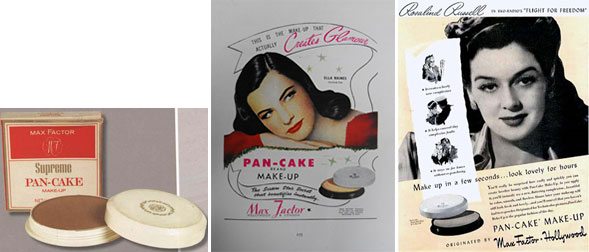
In 1936, the Max Factor company obtained the first of two patents for a new make-up base designed specifically for the Technicolor film. Originally used in the film “Vogues of 1938” (Walter Wanger Productions), it was released in 1938 under the name “Pancake” to the general public. It has been an incredible success for the Max Factor company. It was first widely copied before eventually defining an entire group of cosmetics.
It then took many years to see remarkable progress. The most well-known application is quite possibly a titanium oxide doped with iron oxides, also known as Photogenica or Photolight ™. Exposure to light of the pigment causes a change in valence of the iron oxide which, consequently, changes color and darkens. This process is reversible with the cessation of exposure.
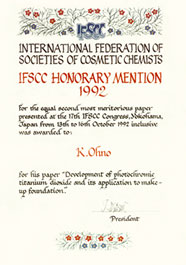 This formulation concept was used initially by Japanese brands, primarily Shiseido which was awarded in 1992 (K. Ohno Paper 31, table 2.1- IFSCC Congress 1992) at the congress of the IFSCC on this topic. Many Western, European or American brands followed.
This formulation concept was used initially by Japanese brands, primarily Shiseido which was awarded in 1992 (K. Ohno Paper 31, table 2.1- IFSCC Congress 1992) at the congress of the IFSCC on this topic. Many Western, European or American brands followed.
Finally, let's make a mention of light-diffracting pigments. These are mainly initially what we call “micatitanes”, made up of a sandwich of layers of metallic elements with different optical properties. At each parting line, the path of the reflected light is altered to create specific reflection effects, ranging from total reflection (white with mother-of-pearl effects) to interference reflections, which makes it possible to create chromatic effects by decomposition of light, like a prism effect.
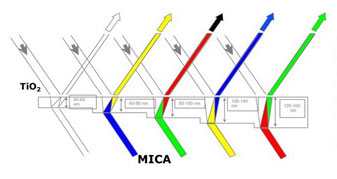
These products can be completed with an outer layer of absorption pigment combining a reflected color and a transmitted color (duochrome effect).
These specialties are used to develop shimmering and pearly colors in virtually all categories of makeup products. They have also been used at low doses and very finely ground to generate skin color correction in certain products with anti-aging claims. In this case, they are called corrective pigments (Chanel 1990).
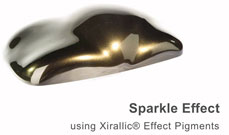 The most sophisticated products, based on silica wafer as a matrix, allow the creation of very attractive multi-interference effects (Xyrallic ™, Merck).
The most sophisticated products, based on silica wafer as a matrix, allow the creation of very attractive multi-interference effects (Xyrallic ™, Merck).
The object changes color depending on the angle of observation or the level of relief.
Another approach is to develop what has been called the “soft focus” effect, and later “blur” or “Blur”. This approach consists of the use of a particular type of pigments having the basic property of diffracting light on the surface of the skin. This leads to a significant decrease in the perception of skin microrelief by a blurring effect, resulting in a smooth appearance. This concept was initially proposed by Japanese teams (Pola in the 80s - Nakamura and all, paper 23, table 21, 14th IFSCC Congress 1986) which subsequently spread with other varieties of pigment.
If, at the beginning, the pigments were mainly constituted by specific shapes, such as silica beads attached to mica wafers, technology has gradually proposed other types of substances such as silica or PMMA beads, Boron nitride or even closer to home, with elastomeric silicone powders functioning as a sort of light trap.
Even more specific approaches have been proposed such as a combination of a soft focus charge and a fluorescent substance, complementing the diffraction of a complementary reflection (EP1099437A1).
Finally, nanometric pigments are the basis of what is called photonic makeup or “Butterfly make up”, by analogy with the color creation process in nature. These pigments are very often nanometric structures that are very difficult to use for technical reasons (optical interference with traditional ingredients) or for regulatory positioning, but they are known. Just like adaptive photo pigments like spiropyrans, but which are not listed in the regulatory framework.
Light in care
There are very few examples where white or other light is used to modify or activate substances for cosmetic use. Beyond applications in the medical field, such as dynamic phototherapy (PDT) or Puvatherapy, only very limited uses are found in cosmetics. In the two cases cited above, we are clearly in medical applications.
In PDT, a technique born at the beginning of the 20th century (1904), the principle consists of applying a substance which is activated with light. The molecule then becomes cytotoxic and destroys sensitive cells.
Among the candidate molecules, there is aminolevulinic acid or more generally methyl aminolevulinate. This substance penetrates cells and sensitizes them to light. The lesions are then illuminated with a specific light (red at 630 nm), which leads to the elimination of the cells concerned. No cosmetic application is known, at most procedures for correcting skin cancer associated with the sun.
PUVA therapy is an effective photochemotherapy in certain skin diseases, of which psoriasis is one of the main indications. It combines a drug, psoralen, and an ultraviolet illuminant. Psoralen, under the effect of light, forms bridges with DNA strands, which leads cells to apoptosis and leads to their elimination. There has indeed been a well-known attempt to use this principle to improve melanin formation by sensitizing the skin to UV. This is the famous episode of Bergasol ™, a sun protection product capable of causing a faster tan . But it ended with a ban. The peptides currently proposed in this field are not sensitive to light.
If we are specifically interested in cosmetic applications, we will first of all retain, in the dental field, the teeth whitening devices that have existed. Starting with baking soda, but especially via a peroxide (hydrogen peroxide, carbamate or urea) which produces hydrogen peroxide under the effect of white light, we can hope for a relative whitening of the teeth. At home, it is mainly peroxide solutions applied through specific ducts that exist, with little lighting device. A practice in specialized salons, known as “tooth bars”, using suitable devices, existed in a fleeting way.
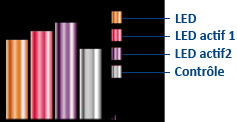 In the field of anti-aging, the most successful work has been done by a manufacturer, Sederma, who proposed a combination of active ingredients, each of which is potentiated by the effect white light. This combination of Darutoside (a pure plant healing molecule extracted from Siegesbeckia orientalis) and a matrikine (lipopeptide stimulating the production of proteins and matrix constituents such as collagen, elastin, hyaluronic acid) was used by Filorga in its Lumitherapist ™ device.
In the field of anti-aging, the most successful work has been done by a manufacturer, Sederma, who proposed a combination of active ingredients, each of which is potentiated by the effect white light. This combination of Darutoside (a pure plant healing molecule extracted from Siegesbeckia orientalis) and a matrikine (lipopeptide stimulating the production of proteins and matrix constituents such as collagen, elastin, hyaluronic acid) was used by Filorga in its Lumitherapist ™ device.
Finally, we can mention the often described biocidal effect of blue light. Its indications are skin imperfections, such as pimples or skin efflorescences, associated with bacterial development. There are several devices specifically positioned in this segment. But in this case, it is the direct effect of the wavelength which is in question, and not the activation of a substance.
Contribution made by Jean Claude Le Joliff |

 A biologist by training, Jean Claude Le Joliff has been an R&D man for many years. Successively in charge of R&D, then Research and Innovation in a large French cosmetics and luxury group, and after experience in the creation of a research center (CERIES), he turned to innovation management.
A biologist by training, Jean Claude Le Joliff has been an R&D man for many years. Successively in charge of R&D, then Research and Innovation in a large French cosmetics and luxury group, and after experience in the creation of a research center (CERIES), he turned to innovation management.





